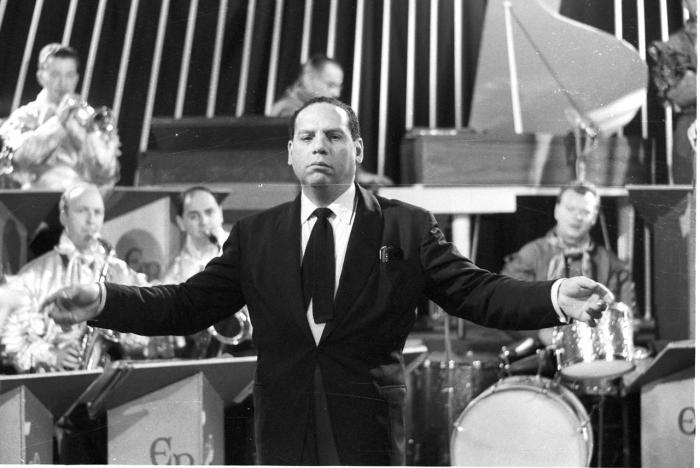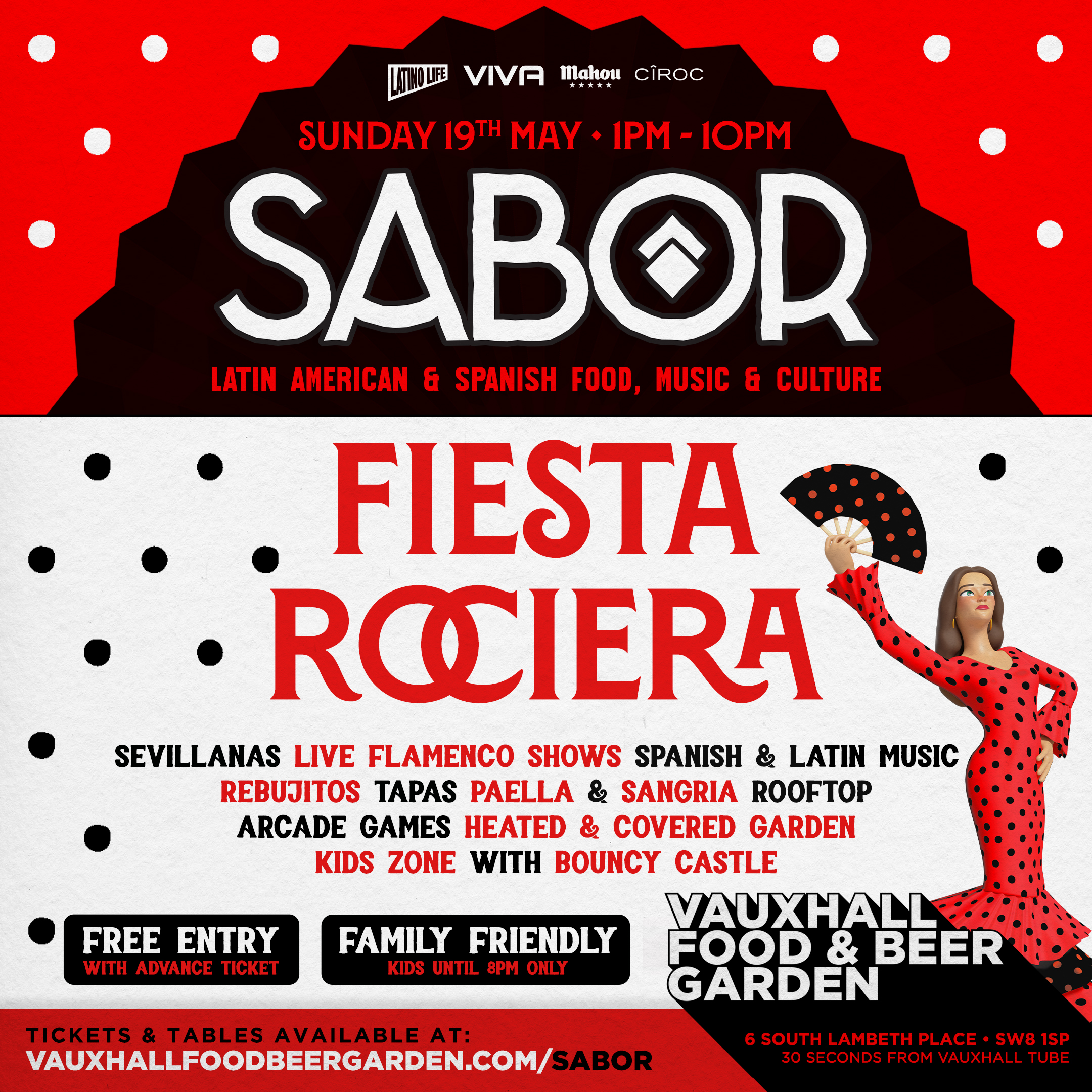It was like starved animals finally being given a morsel, the way the audience relished the unmistakeable Salsa beat. Their delighted faces bathed in the soft concert lights of the Barbican hall, gleaming as the warm tickling rythmns of the timbál, conga and bongó washed over them like a wave of relief. They clapped to the clave uninvited, ran down to sway their hips and were in fully-fledged salsa heaven before the first song. It was a rare scene of unity between London’s Colombianos and the tassled-skirted Essex Salsa freaks. The orchestra itself reciprocated this joy, for this was a now infrequent invitation to play to a British audience, and to be televised by the BBC.
But while all were losing themselves in the Palladium 3 Orchestra, playing to inaugurate a new BBC series on Latin Music USA, one could help but ask; what has happened to Latin Music in the UK? Latin music lovers have infact been starved in recent years. according to Latin music promoters such as Andy Wood, who puts on La Linea every year. A “historical slump” in the Live Latin Music market. He calls it. At the moment it just doesn’t work financially to bring live Salsa bands to the UK anymore; the bands are too big and the audience numbers just not there.”
The irony is that the salsa class business is booming; you can’t pass a pub in England without seeing a big plastic sheet advertising weekly lessons. Even Arlene Philips, face of prime time shows like Strictly Come Dancing and So You think you Can Dance and Middle England’s reference for dance announced a “salsa explosion’ across the country, as Cuban dance Diva Yanet Fuentes (well known on of the salsa circuit) was dazzling Saturday night viewers with her sexy moves. And yet music industry pundits recognise that the “The Latin Boom,” as The Evening Standard described the climax of Latin Music popularity around ten years back, has died.
On the surface it’s a mystery why the success of Salsa as a dance coincides with its failure as a music, when the two grew together and are so inextricably linked. And yet there is a very apparent disconnect between the two. Britain’s most successful Salsa and Latin Jazz pianist, Alex Wilsons laments “the distancing between the Salsa dancer and musician.”
Other music purists would even say that the Salsa dance culture has killed off the music, with its cliquey, obsessively ritualistic atmosphere. But what exactly is the relationship between the two and where did it all go wrong?
A Brief History of Latin Music in the UK
Many would be surprised to know how long Latin music and dance has been popular in the UK. Back in the 1940s Cuban Band leader Don Marino Barretto made his name playing to pilots on the Salisbury Plain during the Battle of Britain. After the war Barretto passed his band over to Edmundo Ros who became the most successful musician in Britain across the board. He owned three night clubs in the West End and, as a regular DJ on radio 2, his programmes and concerts became the ‘housewives choice’, as he tailored his Latin sound to the English ear by emphasising melody over rythmn. The original ‘Come Dancing’ phenomenon revolved around what he did.

The Latin fad gave way to the ascent of Rock ‘n’ Roll and Pop of the sixties but in the seventies and eighties it came back, in a different form, when political refugees started to flood in from the wave of dictatorships sweeping through Latin America. With the political migrants, many of whom were creative types and musicians, you had a developing interest in the Nueva Trova and Canción de Protesta of the likes of Mercedes Sosa and Silvio Rodriguez.
The exiled years of Brazilian legends Gilberto Gil and Caetano Veloso in West London added much allure to this cool London sub-culture. Even though, in these de-politicized times, it is difficult to imagine political Latin Music having widespread appeal, Andy Wood, who started his career as a promoter putting on concerts for the Nicaragua Solidarity Campaign (NSC) describes a buzzing scene that tapped into the broader politically activity in Britain in the seventies and early eighties. “The Nicaragua Campaign had thirty full time staff and brought loads of artists. We had support from the Great London Council (run by the infamous “Red” Ken Livingstone) who helped bring the likes of Rubén Blades and Silvio Rodriguez and they were all sell outs. This was before the dance class boom started; people enjoyed dancing to live salsa, without worrying whether they were dancing on the one or the two.”
It also coincided with the advent of World Music which was being promoted by mainstream music magazines such as NME, displaying artists like the Bhundu Boys on the cover for the first time. This, together with the revival of traditional Cuban music, prepared the ground for the huge success of Buena Vista Social Club in the nineties. Then, of course, came the invasion of the commercial superstars Gloria Estevan, Ricky Martin, and Shakira, which became the Saturday night anthems of the Latin themed bars that were springing up all over London such as Havana and Bar Salsa. During these climactic years for Latin Music, Andy says, “there was a perception that Latin Music was interesting. It had its moment. But there is a general sense now that Latin Music is just not trendy at the moment”
The Ascent of the Latin Dance Culture
Working in tandem, came the ascent of Latin Dance culture in the UK, which was taken up with equal verocity by a very different crowd, extending beyond London, and taking the initial big band interest of the forties and fifties on a different road. “England was the first country to institutionalise salsa dancing,” says DJ Jose Luis. “ It imposed rules to the dance and regulated the environment; it was the first place in the world where you could get a certificate for being a salsa teacher.” Although this treatment of a dance and music that came from the street and was never ‘taught’ in Latin America appears to be the reverse of what salsa is all about, it certainly shows an appreciation. From Salsa congresses and tour agencies that take plane loads of English tourists on ‘Salsa holidays’ to Cuba or Cali to globe-trotting super teachers and Salsaerobics in the burgeouning gyms chains, our very British enterprise gene created an entire Salsa dance industry that Latinos themselves never dared imagine. The English have even made a verb out of the noun – “Do you Salsa?” people ask, as if it were a lifestyle choice. Though they share the same name and geographical roots, Salsa the music and Salsa the dance today represent two very different, perhaps even conflicting worlds. Worlds Apart – The Salsa Scenes Initially, the two worlds of Salsa did coincide.
Paul Young, who until recently congregated thousands of Salsa lovers in weekend congresses, says “When I got into Salsa in the early 90s it was still mainly Latino and the music had a central place in the dance culture. Then you had teachers like Robert Charlamagne who took the dance teaching to a whole new level. By 2000 there was a marked shift between people doing salsa rather than listening, and the different motivations of the two groups became more apparent. Now the Salsa dance scene is predominantly British, and you have exclusively Latino clubs again. It’s gone full circle.” Indeed, the huge waves of Colombian immigration from the seventies to the late nineties, estimated at several hundred thousand, certainly played a part in kicking off the Salsa club phenomenon in the early nineties.
The Colombians had their own Salsa clubs but also spilled over into London’s mainstream Latin clubs such as Bar Salsa, La Finca, Havana, where they merged with the English Salsa scene. “I was very into promoting music alongside the dance,” says Paul, who brought the likes of Spanish Harlem Orchestra, Eddie Pamlieri and Camilo Azuquita to his congresses. But he was working against a different trend. “I realised more and more that there was very little interest amongst the English Salsa goers in the music. It was basically a backdrop. Looking back I could have saved myself thousands of pounds by not bringing all those expensive Salsa bands and probably nobody would have complained!” Latin Musicians in the UK here have expressed a lot of frustration at this lack of appreciation for live music, evident in the low pay.
As Wood explains; “Live Salsa bands demand a certain degree of focus and don’t always play dancers’ favourite song and, in the end, it’s cheaper to pay a DJ who can guarantee the crowd pleasing tracks.” The Salsa artists that have been most successful in the UK have been the ones that have been able to connect with the dancers’ needs, such as Alex Wilson. “I’m not saying that you have to totally bend your music to the audience and play La Bamba all the time,” says Wilson. ”Its about understanding the audience. People work hard all week, they want to let off some steam on the dance floor, and you’ve got to play the music that allows them to do that. There is a time and a place for everything. I can play Latin Jazz and fifteen minutes tracks and loads of licks and impro elsewhere. I enjoy playing the dance format. You have to say what you say in five minutes and that’s a challenge in itself. Salsa dancers come out to dance not to listen to the music and until you realise that as an artist its going to be very frustrating.”
Paul Young agrees, “Alex and I talked a lot about building the relationship with the dancers, and Spanish Harlem did the same. They used to say they wanted to dancers to enjoy it. It doesn’t get you anywhere to complain about your audience, you have to work with the one you’ve got. There is a huge audience for salsa you just have to know how to tap into it.” The problem is, however, that the salsa scene stopped attracting many punters because of what developed into what Andy Wood calls the “tyranny” of salsa dancing. The atmosphere in the clubs became quite cliquey – a cross between an exercise class and speed dating. If you didn’t know your Cuban style from your New York style, you could pretty much be left on the sidelines. People, including Latinos, stopped enjoying it. And when the Latinos stopped going, it stopped being “cool” It’s not all the fault of the English salsa dancers though. There is a big section of dancers that do appreciate live music,
"I have a huge respect for the culture, " says Susana Montero, Britain's most succesful Salsa teacher. "But It's not always as easy for English people because of the language. Latin musicians need to make an effort to talk to the audience and adapt to the event, and do everything they can to draw the audience into their music." The English Salseros may not be the most inclusive and open, but go to one of the Colombian clubs in Elephant and Castle, where they are singing all the words to the songs and sit and dance in groups, and you will just as easily be left on the sidelines feeling like a fool. And while the English may be more interested in spinning than cultural appreciation, the Latinos who came down to the clubs exclusively to rub up against English girls, weren’t exactly there for the live music either.
Both sets of Salseros have played their part in giving Salsa a naff image. In recent years the rift has only grown, with Latinos veering towards Bachata and Reggaetón and some English Salsa clubs going even more left field by playing no Salsa at all. In a gradual progression from Salsa remixes of R &B favourites to not even bothering with the remixes, says Paul, “you now find punters dancing Salsa to R&B all night. Now that IS bizarre.” Salsa: a Dying Art Form? Meanwhile, neither of these worlds appeal to the third audience for Latin Music - the World Music crowd, who also have their narrow definition of what Latin Music should sound like and are reluctant to venture any further.
The experience of the Buena Vista Social Club showed this. Some wonder why Buena Vista’s producers didn’t capitalize on its huge success to discover and promote the wealth of talent that exists elsewhere in the Latin America. Following what Ry Cooder did with the Cuban lot why have there been no collaborations with mainstream musicians here to bring to the fore the outstanding talents of Cuba, Venezuela and Colombia? Nick Gold, executive producer of the Buena Vista albums, says simply “There was so much talent within that group and we were so busy releasing their albums every year, which did so well, that we just didn’t have the time or need to look elsewhere. It was never my intention nor my responsibility to represent the whole of Latin America. Besides I just didn’t take to a lot of the other Latin Music being produced.”
From the World Music perspective, a lot of Latin Music, especially Salsa, sounds too slick and commercial. Rootsy, rustic and organic are the preferred production values of World Music fans over say, the romantic Salsa of Luis Enrique or, or the slick melodrama of Marc Anthony. They would surely never see through the shoulder padded suits to appreciate the genius of Frankie Ruiz - all too idiocyncratically Latin for Worldy music types, however ‘open minded’ they think they are.
Are the Europeans more appreciative of live Latin Music? Some, like DJ Jose Luis, think so. ”A band like Charanga Habanera will do five or six concerts in just one region in Italy, but would be lucky to fill one night in the UK. Salsa has a much cooler image on the continent, it doesn’t have that ballroon granny image it has here. When I went to Rimini I noticed how much younger the salsa audience is there, average 25 rather than 35 as it is here. They travel to Cuba, learn the language. Very few English salsa teachers have learnt to speak Spanish or show any interest in the culture or promoting it, despite making a living out of it. In Paris you have artists such a Yuri Buenaventura and Azuquita who have been playing successfully for decades and making a good living, plus new successes like Orishas. Here Latino artists are all struggling.”
Susana Montero agrees and says that the teachers and promoters in the UK should be setting more of an example. "The Italians and Spanish obviously have an advantage because they understand the language better, but take the Germans. They came to Salsa later than the British but with a better approach. They spend a lot longer learning before presenting themselves as teachers. All over Holland, Germany and Scandinavia you have schools that teach not only the dance, but include the culture and music as part of the package.
In Britain, there are a lot of teachers now who are not properly trained and have no real interest in the culture, language or music, but just want to make a quick buck, and this has brought down standards and devalued Salsa on every level, the dance, the music and the culture in general." salsa dance group Others believe that, even though the continent might be slightly more appreciative (also perhaps because their own music industries are smaller than the UKs and so look outwards more) the Salsa crowd is pretty much the same everywhere. The difference in Europe, all promoters agree, is that you have huge state subsidized festivals that pay for artists to come. “Here in Britain, you don’t have nearly the level of subsidies for putting on concerts that you do in Europe.” Says Wood. ”Plus things like hotels and venue hire are much cheaper on the continent. Latin Promoters are not working in such a straight commercial way as they are here. In Britain, music is left to the market in a way it isn’t there, so its difficult to say whether there is really more of a market for Live Latin Music in Europe.”
And here is where we touch the naked truth. Is Salsa really saying anything new and innovative that merits caputuring new audiences or is it just rehashing the same old sound? Being at the Barbican Hall, where Palladium 3 Orchestra and La Excelencia played courtesy of the BBC, was a stark suggestion that going to see Salsa of this kind is little more than a trip down nostalgia lane. “We always used to open La Linea with a salsa band,” says Andy. “But La Linea is about New Latin Music and sadly there is not a lot new happening in Salsa.” The New Era Of course the great bands such as Los Van Van that are able to reinvent themselves through the generations will always fill out venues.
Yet, even Jeremy Marre, who made the BBC documentary series rtesponsible for bring the Big Palladium 3 Orchetsra admits: “Salsa is just not relevant now in the way it used to be.” Meanwhile in clubland, there is a new dawn in Latin Music which is bringing together Latinos and London’s cosmopolitan club scene again in a way that has been missing for years. And it revolves around Urban Latin Music, which is rocking Latin America and the US in the same way that Salsa did in the seventies. Like all genre, there is a lot of rubbish around, but with its creative fusions of Bachata, Bomba y Plena, Salsa, Hip–hop and House it is the expression of that Afro-Latin American Caribbean. Within the genre are genii like Tego Calderon, who are breaking ground in the way Ismael Rivera did. And young people are loving it.
The young Latinos of London have been infusing clubland with this new energy over the last five years. At La Bomba, London’s biggest Urban Latin party, you’ll get Asians, Jamaicans, British Caribbeans, Algerians and Persians all loving the vibe. In a second room couples smootch to Salsa and, more and more Bachata, the new flava. “It’s an inclusive atmosphere, its about having a good night and about the music,” says La Bomba promoter DJ Jose Luis. “I like seeing people dance but I don’t like people judging others who don’t dance as well. Let’s hope the dance ideologues don’t do the same to Bachata as they did with Salsa.” Indeed, music for couples to dance to whether Salsa or Bachata, always has and always will hold an appeal and Susana Montero believes that artists, promoters and fans to come together to reassert Britain as the cultural pioneer it once was. "London was THE capital of Salsa, but we've been left behind the rest of the world because we got complacent. English people ARE interested, but teachers need to educate themselves better and then incorporate it into how they teach, otherwise they can't feed that interest."

















